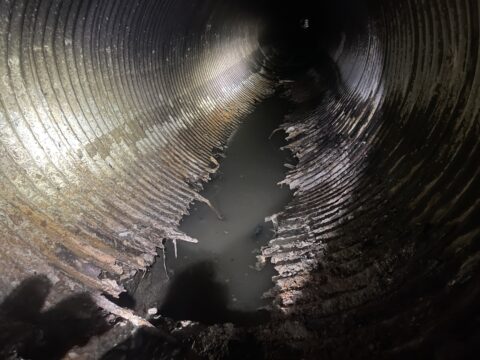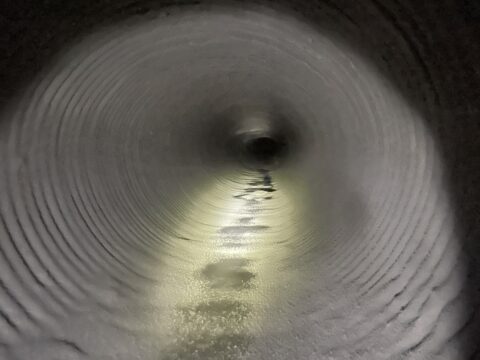WATER/WASTEWATER
ISSUE
The City of Chula Vista located in Southern California identified a 720 linear foot section of 66-inch CMP storm drain was experiencing a rapid deterioration of the structure including the corrosion of invert, ovality of the pipe and ground water infiltration.
SOLUTION
National Plant Service from Long Beach CA bid from the project and won after it provided a design thickness calculation, material to be used, verification testing reports and a list of past projects using the material, as required in the bid submittal package. This evidence proved to the City of Chula Vista that the pipe, once rehabilitated, would meet the city’s quality standards.
National Plant Service’s Project Manager Daniel Solano lead the team carrying out the rehabilitation. The following steps took place:
New Manhole Installation
The city required two new manholes to be installed to allow for easier future maintenance and inspection access. The manholes were cast-in-place, and the site was excavated down to the crown of the pipe. Formwork was installed in stages before backfilling upon completion of each section.
Cleaning the pipe:
There was a significant layer of debris covering the invert of the pipe along the entire length. Approximately eight cubic yards of material was removed.
PROJECT DETAILS
Location: City of Chula Vista, Southern California
Application: 66-inch CMP storm drain
Installation: June 2022
Client: City of Chula Vista
Installer: National Plant Service

Invert Repair:
Cleaning of the storm drain revealed that the invert was severely corroded, and approximately one to two feet width of the CMP pipe was missing throughout the entire 720 -foot reach. A new concrete invert was poured to fill the voids and bridge the gaps in the CMP pipe. Locally sourced 3,250 PSI concrete was used and allowed to cure.
Injection Grouting to stop Infiltration:
As typically occurs when an invert repair is made, water that used to flow under the failed invert can no longer escape the backfill and builds up around the exterior of the pipe. The water can then find its way through any gaps in the CMP pipe. Acrylamide grout is effective in stopping infiltration into pipelines as it binds with the surrounding backfill to provide a waterproof collar around the outside of the pipe, preventing further infiltration. Manual grouting was performed whereby holes were drilled through the pipe wall where infiltration was present, and an injection port was inserted to introduce the two-component grout mix, which fills behind the pipe, binding with the soil to stop future infiltration.
Spin casting of the geopolymer structural mortar lining
After grouting was complete, and infiltration was stopped, the pipe was ready for spincasting. The pumper/mixer assembly is placed near the access manhole along with pallets of pre-mixed dry material supplied in 50-pound bags. Concrete hoses were run from the pump into the manhole and through the pipe to the spinner sled at the far end of the pipe segment to be lined. The geopolymer dry mix is mixed with a measured amount of water as it leaves the pump, and travels through the hoses to the spinner sled. A winch is used to pull the spinner sled back at a controlled speed to ensure the correct amount of geopolymer was released. Multiple passes, or lifts of material, are usually required to reach the design thickness, with an initial thinner lift often required in CMP to allow for better bonding of future, thicker, lifts.



